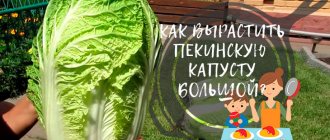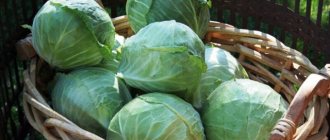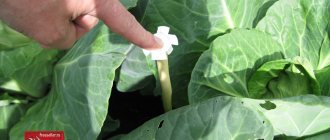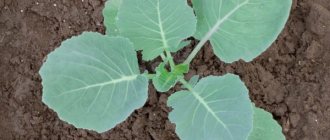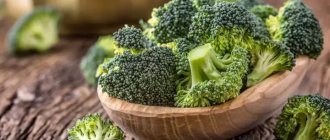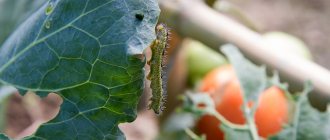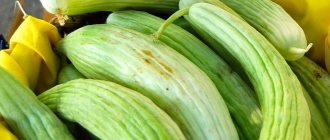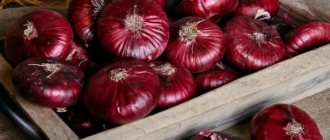Author: Elena N. https://floristics.info/ru/index.php?option=com_contact&view=contact&id=19 Category: Garden plants Published: April 26, 2017Last edits: January 06, 2021
- When to plant kale in the ground
- Caring for Kale Cabbage
- Processing kale
- Kale cabbage for the Moscow region
- Health benefits of kale cabbage
Kale cabbage, or kale, or Grunkol, or Brunkol, or Braunkol, or curly cabbage (Latin Brassica oleracea var. sabellica) is an annual vegetable plant, a variety of the Cabbage species of the Cruciferous family. This is a leafy vegetable that does not form a head, unlike other varieties of cabbage. Kale leaves resemble curly lettuce leaves. Kale is very similar to wild cabbage, but its origin has not yet been established for certain, although it is known that until the end of the Middle Ages, kale was one of the most common vegetables in Europe. At the beginning of the 19th century, Russian traders brought it to Canada, and during the Second World War, due to its high nutritional value, kale began to be widely cultivated in Great Britain.
We will tell you about growing kale and caring for it and try to answer the following questions:
- when to sow kale for seedlings;
- how to plant kale cabbage seedlings;
- how to grow kale seedlings;
- how and when to plant kale in open ground;
- what are the conditions for growing kale cabbage in open ground;
- what varieties of kale are there for open ground;
- how to harvest and store this variety of cabbage;
- What are the benefits of kale cabbage, and is there any harm from it?
Planting and caring for kale
- Planting: sowing seeds in open ground - at the end of April or at the beginning of May. Sowing seeds for seedlings - at the end of March or early April, planting seedlings in the ground - around mid-May or towards the end of the month.
- Lighting: bright sunlight.
- Soil: fertile, permeable, with a pH of 5.5-6.8.
- Watering: abundant, and during periods of drought even frequent: the soil on the site should be slightly moist all the time.
- Fertilizing: every 6-8 weeks you need to add organic (herbal infusion or compost infusion) or mineral fertilizers to the soil. The first feeding is carried out when the leaves begin to grow.
- Reproduction: seed.
- Pests: cabbage aphids, weevils, cutworms, white moths, moths, flies, cruciferous flea beetles, rapeseed sawflies and flower beetles, mole crickets, wireworms and slugs.
- Diseases: clubroot, blackleg, downy mildew, fusarium, ring spot, white and gray rot, mucous bacteriosis, rhizoctonia and viral mosaic.
- Properties: the plant is a valuable dietary product.
Read more about growing kale below.
Optimal planting dates
Since curly cabbage grows and develops quickly, and also tolerates low temperatures, it begins to be propagated long before the onset of the summer thaw. Seeds are capable of producing the first shoots already at a temperature of +5...+10°C, so they resort to sowing crops in open soil in temperate climates at the end of April.
Read more about the cabbage varieties Aggressor, Rinda and Romanesco.
In this case, the crops must be provided with a protective cover made of polyethylene or other materials. The seedlings are planted a little later - for this the air must warm up to at least +15°C. The most optimal microclimate for this occurs in the first half - mid-April.
Kale - description
So, kale is a leafy cabbage that does not form a head. Only the large curly leaves of kale cabbage, which are bluish, red, green, and, after cold weather, purple in color, are eaten. The stem of the plant is too hard and not suitable for food. Before the Renaissance, kale was the most widespread cruciferous crop in Europe, but it was cultivated as early as the 4th century BC in Ancient Greece, for which there is irrefutable evidence. Today in Holland, a traditional dish called stamppot is prepared from kale cabbage, mixed with mashed potatoes and served with sausages. In Japan, this variety is popular as an additive to the drink aojiru, and in Turkey, kale, rich in calcium and vitamins, is used to make soup.
What kind of cabbage is this
Kale is a leafy plant. Depending on the variety, it can reach a height of 0.4-1.5 m.
The leaves, corrugated or carved along the edges, resemble lettuce or curly parsley. They can be green, red or red-violet.
The plant is valued not only for its content of nutrients and vitamins, but also for its high decorative value.
It is recommended by nutritionists as a product rich in vegetable protein, mineral salts, biologically active substances and vitamins.
Growing Kale from Seeds
When to sow kale for seedlings
Kale cabbage does not tolerate transplantation well, so it is better to sow it directly into open ground, but if you decide to use the seedling method of growing, then you need to sow the seeds 5-6 weeks before planting the seedlings in open ground - during the period from late March to early April. Choose the most favorable day of the lunar calendar for sowing cabbage and get started.
- How to sow chives for seedlings
Growing Kale Seedlings
Kale cabbage is sowed for seedlings in containers or boxes, although it is better to sow three seeds in separate cups - kale, like any other cabbage crop, does not like transplants. Before sowing, kale seeds are soaked for 20 minutes in water at a temperature of 45-50 ºC, after which they are immediately immersed in cold water for 5 minutes. Then the seeds are wrapped in a damp cloth for 2-3 days and placed in a warm place, and as soon as they sprout, you can sow kale cabbage. The substrate for seedlings is made up of fertile soil and sand in a ratio of 1:10, fertilized with compost and disinfected by calcination in the oven or spilled with a dark pink solution of potassium permanganate. The seeds are laid out in a well-moistened substrate at a distance of 5-8 cm from each other, planted to a depth of 1.5 cm, after which the soil is lightly pressed down and the crops are covered with film or glass. Keep the container in a warm place, removing the film daily for 1-3 hours for ventilation, and when shoots appear, the box is moved as close to the light as possible.
Planting and caring for Chinese cabbage
Kale cabbage seedlings need the same care as seedlings of any other cabbage - they need to be grown in slightly moist soil, remembering to ventilate the room, while at the same time protecting the seedlings from drafts.
Kale cabbage pick
Kale from seeds, like any other type of cabbage, does not tolerate pickling. It is planted in open ground along with a lump of earth, trying not to damage the central root, but before planting, the seedlings must undergo hardening procedures, consisting of daily sessions in the open air, the duration of which should gradually increase until the seedlings get used to the new habitat. When the seedlings are 45 days old, they have formed 4 leaves and reached a height of 8-10 cm, they can be planted in the garden bed.
Kale cabbage is planted in deep holes located at a distance of 30-40 cm from each other with row spacing of 45-55 cm. In each hole you need to throw 200 g of wood ash and 100 g of humus. The seedlings are immersed in the ground along the first pair of leaves, watered and the hole is filled with earth.
Transplanting
Most often, Kale cabbage is planted as seedlings. It is grown at home. Prepare a soil mixture of 10 kg of peat and 5 kg of sand, add 2 kg of humus. Before sowing, the mixture should be warmed in a warm room to 25 C:
- It is recommended to disinfect the seeds in a solution of potassium permanganate and dry them in the oven at a temperature of 50 C;
- sowing is carried out in boxes or individual containers;
- deepen the seeds by 1 cm;
- cover with film. The film is lifted daily to ventilate the soil;
- watering is carried out once a week;
- withstands temperatures of 25 C;
- sprouts appear after 5 days.
After the emergence of seedlings, the film is removed, the temperature is reduced to 18 C. Daylight hours are increased to 13-15 hours. Lamps are installed above the seedlings. Planting in an open area is carried out after a month, when 4 openwork leaves appear on the bush.
Mature plants are characterized by increased resistance to low temperatures. Seedlings are no exception. When landing, the air temperature can be from 5 C to 30 C.
When planting kale cabbage, it is not recommended to use mulch. It is a haven for slugs. You can mix mulch with ash, coffee or ground red pepper. Shellfish do not tolerate these substances. After a month, it is recommended to sprinkle the formed bush with a solution of pepper.
The bushes are not covered with a film tunnel. In order to adapt to new conditions in a short time, it is recommended to harden the seedlings.
More on the topic: What is the Miracle cabbage variety for the record?
Before planting, it is recommended to dip the roots of the seedlings in a mash of clay and ash. This is prevention against fungus and pathogenic bacteria. Some gardeners use the drug Shine-1, Immunocytophyte.
Igor Nikolaev
auto RU
These products increase plant immunity. A hole is made along the length of the stem. Only leaves are left above the soil. The bush is sprinkled with earth on all sides and lightly compacted.
Planting kale cabbage in open ground
When to plant kale in the ground
If you decide to sow kale cabbage directly in open ground, then you need to do this in the last ten days of April or the first ten days of May - kale cabbage is cold-resistant, and its seeds begin to germinate already at 4-5 ºC. It is best to grow kale in a sunny area. Keep in mind that the crop can grow in one place for three years: if in the fall, when cutting cabbage, you leave a couple of centimeters of the stem above the surface, the next year you will get an early harvest of curly cabbage. The best precursors for kale are nightshade, legumes and pumpkin crops, and the worst are vegetables and cruciferous crops.
Growing cabbage from seeds - planting and care
Soil for kale cabbage
The soil for kale cabbage must be fertile - if grown in clay or sandy soil, you will not achieve good yields, and the cabbage will have a mediocre taste. An indicator such as soil water permeability is also very important for kale cabbage, since the crop does not tolerate stagnation of moisture in the roots. The soil pH should be between 5.5-6.8 pH. If the pH is below 5.5, add compost to the soil, and if the pH is above 6.8, dig up the area with granular sulfur. The bed for kale cabbage is prepared in the fall - it is cleared of weeds and dug up, and immediately before sowing seeds or planting seedlings, humus and complex mineral fertilizers are added to the soil.
How to Plant Kale
Sow cabbage seeds in holes located at a distance of 30-40 cm from each other with row spacing of 45-55 cm. When sowing, as when planting seedlings, throw 100 g of humus and 200 g of ash into each hole, put three to five seeds , water them and cover them with soil. Then the bed is covered with plastic film, securing it along the edges so that the wind does not tear it down. Shoots will begin to appear in 5-7 days, and the film can be removed, and when inspecting the emerging shoots, the weak ones can be removed so that they do not interfere with the development of stronger plants.
Planting with seeds
Kale is planted in the spring. In the southern regions, seeds are used. Outwardly, they are similar to the seed of white cabbage. Sowing is carried out when the soil warms up to 3 C. It is recommended to prepare the site in the fall. Humus, sand, and peat are added to it.
Up to 20 kg of compost and 5 kg of sand are added to depleted soils. Be sure to add ash, 1 kg/m2. It prevents the appearance of mold and the development of putrefactive bacteria. 2 weeks before sowing, mineral fertilizers, urea and ammonium nitrate, 20 g/m2, are applied to the site:
| № | Helpful information |
| 1 | holes are made in the garden bed at a distance of 60 cm |
| 2 | put a little sand and ash in each |
| 3 | deepen the seeds by 1 cm. Sprinkle with prepared, fertile soil mixture |
| 4 | if the soil is wet, then watering is not carried out |
| 5 | cover the crops with film or lutrasil until sprouts appear |
| 6 | Shoots appear in 2-3 weeks |
Some gardeners play it safe and place several seeds in one hole. If sprouts appear from all the seeds, then the seedlings need to be thinned out.
Correction of planting density is carried out when 4 leaves appear on the bushes. The removed seedlings are placed in other holes and are not thrown away. Watering is carried out as needed, but at least once a week.
How to Grow Kale
Caring for Kale Cabbage
How to grow kale? Caring for kale cabbage in open ground is not much different from caring for any other variety of cabbage. Growing seedlings need watering, weeding, hilling, loosening the soil, fertilizing and protection from pests and diseases. When the kale cabbage in the garden reaches a height of 20-25 cm, it needs to be hilled, and if weak leaves begin to appear on it, they must be removed immediately. To make it easier for you to care for cabbage and to prevent it from being affected by root rot, mulch the area with compost or humus.
Watering kale
To ensure that the water does not spread out when watering, but goes directly to the roots, make a circular furrow around each plant and pour water into it. In dry times, you will have to water the cabbage more often and more abundantly, and after each watering or rain you need to loosen the soil around the plants and between the rows. The soil in the garden bed should be slightly moist at all times, so be prepared to water your cabbage every day in the hot summer, but still allow the soil to dry out between waterings.
Growing Savoy cabbage - planting and care
Feeding kale cabbage
Despite the pre-sowing application of fertilizers to the soil, kale cabbage in open ground requires organic fertilizing every 6-8 weeks. The first feeding will be needed when the leaves begin to actively grow. To feed plants, a herbal infusion is used, for which a quarter of the barrel’s volume is filled with water, then the barrel is filled with fresh herbs - grass, including weeds - at the rate of 10 kg per 100 liters of water, after which 2-3 kg are added for every 100 liters of water dry chicken manure and cover the barrel with a net. When foam appears on the surface of the mass, the contents of the barrel begin to be stirred daily to stimulate fermentation. Depending on the weather and air temperature, the herbal fertilizer is infused for one to three weeks. As soon as foam stops forming, the infusion can be used for feeding, diluting it in half with water. Fertilizer is applied strictly at the root.
You can prepare fertilizer for kale cabbage from compost: 2 liter jars of sifted compost are filled with a bucket of water and left for a day in the sun, after which the water is drained and used for root feeding.
Growing kale in the Moscow region
Readers ask us whether kale can be grown in the middle zone. Why not? This variety of cabbage is cold-resistant and resistant to sudden temperature changes, so with the right selection of varieties you can count on a decent harvest in the Moscow region.
Cooking features
Kale is one of the most versatile plants. It is successfully combined in fresh salads with other vegetables or used as a side dish for meat and fish. In this case, it is prepared boiled, stewed and even fried. It can also become the main ingredient in the preparation of vegetarian cutlets, pancakes and other things.
When properly processed, it can be used to prepare pickles, including pickled products, which are not inferior in taste to white cabbage. In the last decade, the vegetable has become one of the traditional ingredients when preparing smoothies. This semi-viscous drink can successfully complement any diet, or be the best option for a healthy snack during the day.
Kale is the best fruit crop that will successfully complement any garden plot. It is nutritious, contains a huge amount of useful substances, and is also suitable for any culinary processing. In addition, such a plant will fit perfectly into any landscape design, since all kinds of Kale varieties also have valuable decorative value.
Pests and diseases of kale cabbage
As for diseases and pests, they are common to all cruciferous crops. Among the insects that pose a danger to curly cabbage are cabbage aphids, weevils, cutworms, white moths, moths, flies, cruciferous flea beetles, rapeseed sawfly and flower beetle, as well as mole crickets, wireworms and slugs. And among the diseases you need to be wary of clubroot, blackleg, downy mildew, fusarium, ring spot, white and gray rot, mucous bacteriosis, rhizoctonia and viral mosaic.
- How to plant broccoli and white cabbage seedlings in the ground
How to plant and grow cauliflower in the garden
We have already described all these diseases and all these pests more than once, so we will not repeat them. Let us only remind you that growing pest- and disease-resistant varieties and hybrids of cabbage, following agricultural practices and conscientious plant care reduces the risk of kale being damaged by insects, fungi, bacteria and viruses to a minimum.
Processing kale
You can protect young plants from cruciferous flea beetle and other pests by dusting their leaves and soil in the garden with wood ash, tobacco dust, or a mixture of these two powder preparations. However, rain washes away the protective powder, and the procedure has to be repeated.
You can spray the cabbage after sunset with seven percent table vinegar diluted in a bucket of water, or a solution of 200 g of chicken manure in 10 liters of water, which must be infused for at least a day before use.
An infusion of onion peels repels insects: pour half a kilogram of onion peel into 4 liters of hot water, leave for two days, filter, add a spoonful of tar shampoo to the liquid and spray the cabbage with this mixture once every 3-4 days.
Growing broccoli from seeds - planting and care
Among the chemicals used to protect against pest invasion, Bankol, Kemifos, Fury, Bitoxibacillin, Kinmiks, Shar Pei, Aliot and others are used, but the use of chemicals is recommended only when it is necessary to save the crop, and folk remedies no longer help.
As for protecting kale cabbage from diseases, in this matter, as in pest control, preference should be given to agrotechnical methods - maintaining crop rotation, growing disease-resistant crop varieties, treating seeds before sowing in a fungicide solution, timely removal of weeds from the site and sucking pests that are carriers of viral diseases, and the destruction of plant residues after harvesting. These measures will protect kale from diseases more reliably than fungicidal drugs.
Content
- Advantages of the plant
- Landing place
- Kale from seeds Seedling care
- Planting seedlings
- Useful material
Rasbak / Personal archive
Beauty Kale (also kale, brauncol, grunkol) - curly kale (Brassica oleracea var. sabellica) impresses and surprises with its appearance. The unusual thing is that it does not form a head , and the leaves are more like salad leaves, attracting with their impressive size and corrugated shape. Green, red, bluish or purple colors - they look very impressive .
Amanda Schutz / Flickr.com
sildid on hippopx.com / Personal archive
Harvesting and storing kale
After sowing, kale cabbage in the ground ripens in 70-95 days, and grown in seedlings - in 55-75 days after planting in the garden. Cabbage leaves begin to be cut when the plant reaches a height of 20 cm. Do not overexpose ripe leaves on the bush - they become bitter and hard. A strongly grown plant can be cut at a height of 5 cm from the ground, and then curly cabbage leaves will again begin to form on the remaining stem.
The cut leaves can be stored in the refrigerator for a week, but you can put them in the freezer and enjoy the taste of kale all winter long—freezing the leaves makes them taste brighter and sweeter.
Planting and caring for kohlrabi cabbage in the garden
Reviews from gardeners
Vera, Moscow region.
There are varieties with green, purple, and burgundy leaves. All of them are great decorations for the garden, and if you are late with harvesting, it doesn’t matter, even under the snow, at temperatures down to -18, it will not freeze and will remain suitable for food.
Source: irecommend.ru
Olga, Belgorod
Very convenient for a small family - you pick as much as you can eat, and the rest continues to grow (it tastes even more interesting when frozen).
Source: otzovik.com
Types and varieties of kale cabbage
Kale comes in several varieties, varying in height. Plants with a height of up to 35-40 cm are considered low, plants of medium height are up to 40-60 cm, and tall are those that can reach a height of 60 to 90 cm. Varieties of kale cabbage differ in the shape and texture of the leaves - they can be flat with wavy edges , medium curl or with terry edges. Varieties and varieties of kale cabbage are also divided into early, mid-season and mid-late. The best varieties of kale are:
- Green kale is a winter-hardy leafy cabbage of medium maturity, reaching ripeness in 75 days from the moment of germination, withstanding frosts down to -15 ºC and capable of producing a harvest again the next year. The plant reaches a height of 80 cm. The leaves of this kale are very curly. The variety is used for making soups and salads;
- Red kale is essentially the same as green cabbage, only its leaves are red;
- Climbing Kale – This variety most often has curly, soft but crisp, heavily wavy purple leaves with a sweetish flavor. Plants of this variety are very attractive, so they are often planted as ornamental;
- Blue dwarf is a compact, easy to grow and very beautiful plant that is often mistaken for an ornamental plant. Despite its small growth, this variety has good productivity. The taste of Blue Dwarf leaves goes well with the taste of pork, legumes, pasta, garlic and mushrooms;
- Black Tuscany - the unusual shape even for kale makes plants of this variety very attractive. The color of the dense, tuberculate leaves of Black Tuscany is dull green with a matte bluish coating. Their texture is similar to savoy cabbage leaves. They are collected from June to late autumn;
- Scarlet - this mid-season, winter-hardy, productive variety has curly, dark green leaves with a purple tint, and after the first frost their color becomes brighter. Plant height from 80 to 120 cm;
- Redbor is a two-year-old, mid-late, cold-resistant hybrid variety with curly leaves of an intense burgundy hue. The palm-like plant can reach one and a half meters in height. The leaves of this variety are used for salads, soups, drying, pickling and decorating holiday dishes;
- Reflex is a high-yielding, winter-hardy mid-season hybrid, distinguished by its decorative appearance and excellent taste of gray-green, highly corrugated leaves, which are considered a valuable component of dietary and healthy nutrition.
Kale cabbage for the Moscow region
Since almost all varieties of kale are cold-resistant, choosing varieties for the middle zone is not difficult. In the Moscow region you can grow Red Kale, Green Kale, Curly Kale, Premier Kale, Mermaid, Dude, Mizun, Cane Kale or Dino Kale. If severe frosts are expected in winter, just remember to cover the bed with a thick layer of mulch, and remove it in the spring when the snow melts.
Kale cabbage for Siberia
The most winter-hardy kale is Siberian cabbage, which is not afraid of even severe frosts and is resistant to any pests, but it is advisable to cover it with mulch for the winter, and when snow falls, throw a snowdrift on the bed.
Popular varieties
There are several types of kale cabbage, which differ from each other in the height of the bush, the color and structure of the leaf blades, as well as the timing of ripening. All hybrids and varieties were bred by breeders based on wild cabbage. The culture is unpretentious and hardy, for which it is valued by gardeners.
Popular varieties of kale in Russia:
- Green dwarf is an early ripening variety. The bush grows in height up to 35–40 cm. The leaves are light green, soft and delicate, with lacy edges.
- Black Tuscany - early ripening, suitable for the southern regions. The leaves are long, narrowed, lumpy, emerald green with a characteristic bluish tint.
- Sibirskaya is a frost-resistant variety; it is grown in the middle zone, in Siberia, and the Urals. The leaf blades are elongated with jagged edges, located on long petioles, and are distinguished by a grayish-green tint.
- Reflex is a tall, mid-late variety with large palm-shaped wrinkled leaves.
- Redbor is a tall, frost-resistant hybrid with beautiful openwork purple leaves. The height of the bush reaches 1 m.
Properties of kale cabbage - harm and benefit
Health benefits of kale cabbage
Why is kale considered the most valuable variety? Because in terms of nutrient density it has no equal among leafy vegetables. It includes:
- minerals – potassium, calcium, copper, magnesium, phosphorus;
- vitamins – C, A, E, K, PP, B1, B2, B6;
- protein;
- cellulose;
- Omega-3 fatty acids, rarely found in plant foods;
- all essential amino acids – 18 essential and 9 essential.
100 g of kale leaves contain only 28 kilocalories. Kale is superior to milk in the amount of calcium, and 200 g of its leaves provide the daily protein requirement.
How to grow Brussels sprouts - planting and care
Kale is useful for calcium deficiency, high eye strain, obesity, as well as for preventing the development of cancer cells and strengthening the body's immune system. Cabbage is also popular in vegetarian cuisine, since it replenishes the body with proteins and vitamins present in meat - it’s not for nothing that this product is called “the new beef.”
- How to protect eggplants from the Colorado potato beetle - prevention without chemicals
Kale - contraindications
Caution when consuming kale should be observed by those who suffer from diseases of the stomach and intestines - gastritis, peptic ulcers, dysbacteriosis and chronic diarrhea, since kale can provoke an exacerbation of pathologies. Another contraindication is diseases of the endocrine system, so people with such diseases should consult a doctor before introducing kale into their diet.
Advantages of the plant
- Gardeners try not only to grow a healthy vitamin product, but also to decorate the area with kale, since outwardly the plant looks very decorative.
- The most remarkable thing is that despite its exotic appearance, kale is an unpretentious plant that does not require special care.
- Another quality that attracts people in this plant is cold resistance . I read that kale can withstand quite significant temperature drops down to -10°C below zero. What makes this type of cabbage the most valuable? Especially in the autumn and spring periods, when abnormal cold comes unexpectedly. It can be kept in a greenhouse until winter and can be planted there in early spring .
naturalflow/Flickr.com
Dwight Sipler / Flickr.com
Harvesting
With proper care, by mid-summer, kale is a gorgeous sight to behold . Sometimes the leaf span is up to one and a half meters.
- When the plant has reached 20 cm in height or more, the harvest gradually harvested . Leaves are torn off starting from the bottom ones .
- They cannot be allowed to grow on the stem for a long time. Leaves too mature become tough and lose their palatability ( you can improve their taste by placing the leaves in the freezer for a while).
- Cutting is carried out throughout the entire growing season , right up to cold weather (leaves caught by frost are even tastier ).
- And if you left your kale to grow in a greenhouse , then the coming winter with its frosts and snows will not be an obstacle to continue enjoying the nutritious product.
Amy Stephenson / Flickr.com
Possible harm
Despite all the medicinal properties, kale cabbage has important contraindications:
- Urolithiasis disease. Cabbage contains oxalic acid, which promotes the formation of new stones in the lumen of the urinary tract.
- Renal dysfunction. Kale is a source of potassium, the removal of which from the body slows down as kidney function decreases. Hyperkalemia can cause seizures or cardiac arrest.
- Taking beta blockers. This group of drugs provokes an increase in the concentration of potassium in the blood. Additional sources of potassium, in this case, are not advisable.
- Taking medications that reduce blood viscosity. The combined use of kale cabbage with anticoagulants, disaggregants or thrombolytics reduces the effectiveness of the latter and increases the risk of thrombotic or thromboembolic complications. The reason is the presence of large amounts of vitamin K in cabbage, which activates the blood coagulation system.
- Varicose veins of the lower extremities. Varicose veins are a potential source of blood clots. The plant significantly increases the likelihood of their formation.
- History of allergic reactions
Kale is recommended for use by women during pregnancy, as it contains the necessary vitamins and minerals for the adequate formation of fetal organs and tissues. However, it is necessary to normalize consumption - no more than 30-50 grams per day.
Curly cabbage has contraindications that are important to consider.
Wonderful kale cabbage: cooking recipes from simple to complex
Many people perceive the browncolleaf plant as an ornamental one, due to its attractive, unusual appearance. However, this is a nutritious, healthy product that is best used for its intended purpose, that is, as food.
Basic rules: how to cook kale
Do you use kale often?
Not really
Only cabbage leaves are suitable for eating, since its stems are excessively tough. The petiole does not contain a record amount of trace elements and minerals, so it can be safely thrown away.
- In dietary nutrition, salads made from fresh leaves that have not undergone heat treatment are recommended. They retain more nutrients.
- To release and easily absorb microelements, it is advisable to chop the salad finely, or better yet, grind it in a blender.
- The first foods that go well with kale are nuts, tomatoes, garlic, green onions, basil, cilantro, parsley, and celery.
- To dress salads, nutritionists advise using extra virgin olive oil, balsamic or apple cider vinegar.
- Low-fat sour cream and eggs go well with cabbage.
You can prepare a salad with meat, poultry and even fish. It neutralizes excess fats well and allows the body to process them efficiently. Therefore, it goes well with smoked meats, bacon, and fatty pork.
Fermented kale
Like regular white cabbage, kale retains its beneficial properties when fermented. To do this, you should choose beautiful, large leaves.
Ingredients
- Kale cabbage – 1 kilogram.
- Carrots – 1 kilogram.
- Purified water – 1 liter.
- “Extra” salt - 1 heaped tablespoon (30 grams).
- Granulated sugar – 1 level tablespoon (20 grams).
Cooking method
Sort the leaves and wash under running cold water. Cut into strips of one and a half to two centimeters. Wash the carrots, peel them, grate them on a fine grater. You can grind it in a blender. Place everything in a large bowl and mix, pressing lightly, as if kneading dough, to release the juice.
Prepare the brine from water, sugar, and salt according to the usual procedure: stir, boil, cool slightly. You can add pepper to it to taste. Place cabbage and carrots in glass jars, compacting tightly. Pour in more hot brine, close with a nylon lid, and leave for three days at room temperature. After this, it can be eaten; it is better to store it in a cellar or refrigerator.
Kale chips
This delicious product, which children love so much, can be made not only from potatoes. Many people praise the browncollet lettuce chips.
Ingredients
- Cabbage leaves – 0.1 kilograms.
- Olive oil – 1 tablespoon (20 grams).
- Salt, pepper - to taste.
Cooking method
Wash the cabbage leaves under running water and place on a paper towel until no drops of moisture remain. Cut or tear them into small pieces with your fingers and place in a bowl. Drizzle the cabbage with olive oil, salt and pepper.
Preheat the oven to 140–160 degrees. Line a baking sheet with parchment or baking paper. Place the vegetable pieces in one layer so that their edges do not touch. Bake for 15-25 minutes until crispy.
Russian salad with kale
If you think that kale is popular only in the West, then you are mistaken. Its Siberian variety is successfully cultivated in Russia. Let's look at the recipe for Russian salad with this vegetable. It is easy to prepare, and the ingredients can be found at your nearest store.
Ingredients
- Kale leaves – 0.2 kilograms.
- Champignons or oyster mushrooms – 0.15 kilograms.
- White beans (boiled or canned) – 0.1 kilograms.
- Hard cheese – 0.1 kilograms.
- Walnuts (chopped) – 30 grams.
- Extra virgin olive oil – 2 tablespoons (40-50 grams).
Cooking method
Finely chop the kale leaves and place in a bowl. Press them with your hands so that they release the juice. Cut the cheese into tiny cubes or strips. Chop the mushrooms and fry over low heat until fully cooked. If champignons are not available, you can use canned or fresh mushrooms, after soaking or boiling them.
The nuts are crushed in a mortar or using a blender, and then mixed with olive oil. Place all ingredients in a bowl, stir, pour over the resulting sauce. Some people add basil for flavor.
Kale and spelled salad
For those who were surprised by the unknown word in the name, it is worth explaining: spelled is a special type of durum wheat. Ksh from this product was once very popular. The gluten content in it is quite low, so it can be consumed without much fear even by those who are intolerant.
Ingredients
- Kale cabbage – 200-300 grams.
- Spelled – 0.5 cups.
- Vegetable broth - 1.5 cups (350 grams).
- Fresh pomegranate seeds - 0.25 cups.
- Lemon juice obtained from one citrus fruit.
- Garlic – 1 clove.
- Parmesan shavings – 0.25 cups.
- Extra virgin olive oil – 2 tablespoons (40-50 grams).
- Pepper - to taste.
Cooking method
Place the spelled in a medium saucepan and cover with vegetable broth. Place on the fire, bring to a boil, then reduce the heat to low and simmer for 25–30 minutes. Rinse the resulting porridge, transfer to a salad bowl, let cool, mix with pepper and salt.
Wash the cabbage, cut into small pieces, and drain so that it releases its juice. Cut the garlic into thin slices or strips. Mix all the ingredients in a salad bowl, mix everything thoroughly, add olive oil. It is permissible to add chopped walnuts, dried cherries, and chopped prunes to this unusual and healthy salad to taste.
Vegetable cream soup from kale cabbage
It is difficult to imagine a healthy diet without soup. Therefore, it is worth knowing that you can prepare such a nutritious, super-vitamin first course from kale.
Ingredients
- Cabbage leaves – 0.5 kilograms.
- Potatoes – 3 pieces.
- Onion – 1 piece.
- Lemon – 1 piece.
- Peeled pumpkin seeds – 50 grams.
- Olive oil – 2 tablespoons (40–50 grams).
- Salt, pepper - to taste.
Cooking method
Peel the potatoes and cut into small cubes. Chop the onion as finely as possible. Rinse the cabbage leaves under running water and tear into large pieces. Heat olive oil in a saucepan, add potatoes, onions, kale. Fry the vegetables for ten minutes, stirring them constantly.
Fill with purified boiling water (preferably vegetable broth) in the amount of two liters, add lemon juice. Reduce heat to low. Cook for 22–35 minutes. The finished soup is ground in a blender until smooth. When serving, add soy cream and crushed seeds.
Interesting Facts
Some more information about superfood:
- In America, kale is called red Russian cabbage, although most Russians have not heard of it.
- Kale can be eaten fresh, cut into salads, baked, or made into smoothies. But don't cook! During the cooking process, practically nothing remains of it, since it consists of 85%
- For a long time, the shoots were grown to feed livestock.
- There is another variety of kale called “Trostyanaya”. It grows to almost two meters tall. Its stem is very tough. Rumor has it that canes are made from it.
Did you know that you can make a walking stick out of cabbage?
Prevention of various problems
When growing this type of cabbage, you should carefully monitor the condition of the leaves . Rotten and wilted ones should be removed so that they do not attract pests. It is important to avoid drought and excess moisture. To do this, the soil around can be mulched.
Kale curly cabbage does not require special complex care, can grow in any climatic conditions and is very useful. Capable of producing several harvests per season until the coldest weather. At the same time, its beautiful appearance will make it a decoration of the site.
If you find an error, please select a piece of text and press Ctrl+Enter.

